Tilcara to San Francisco in Argentina

Caramor - sailing around the world
Franco Ferrero / Kath Mcnulty
Sat 25 Nov 2017 16:46
23:34.36S 65:23.36W The Pacific Ocean was beckoning, it was time to head south, but not without a couple of stops in northern Argentina. The Bolivian-Argentinian border crossing was straight forward but the frequent Argentinian police roadblocks on the only road south were tedious. The officers were rude and their search methods sloppy and pointless, anyone could have smuggled an elephant herd right under their noses. 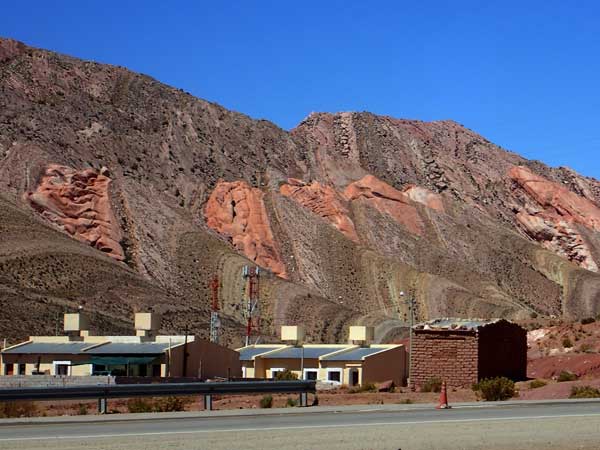 The Devil’s Back geological feature, photo taken while we suffered yet another police check We got out of the van we had been travelling in, on the main road near Tilcara and walked the last kilometre into town. We were in Jujuy Province, in the north-west corner of Argentina. Our plan was to trek the four day route across the mountains to San Francisco in the Yungas. The Yungas is an important ecological zone located on the eastern flank of the central Andes stretching from the north of Peru, through Bolivia to the north of Argentina, a long narrow strip of montane tropical cloud and rain forest. The altitude range is from 300m to 3,800m. At the lower levels, the vegetation is dense humid evergreen woodland which compares from a biodiversity point of view with tropical Amazonia. On the higher slopes, the jungle gives way to deciduous mountain woodland, bushes and pasture. Manu National Park is within the Peruvian Yungas but at the time we hadn’t realised the feature extended as far as Argentina. The Yungas is the water reservoir for the Amazon and Plata Rivers, it also acts as a major wildlife corridor across a great part of South America. 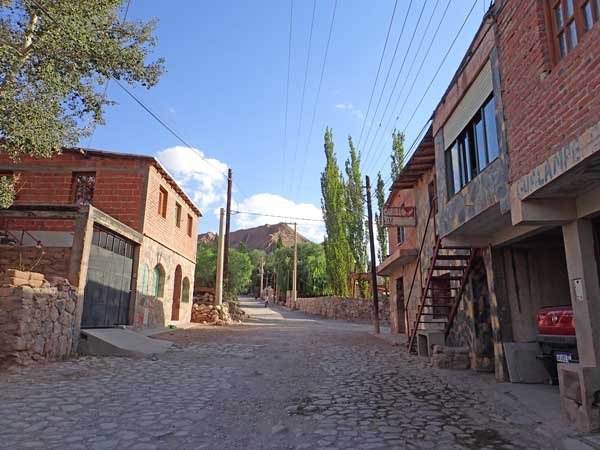 Tilcara Nobody seemed to know much about the walk but we had a few waypoints on Franco’s phone and my Austrian friends (met in Salta) had assured me it was possible. The next day, we spent relaxing and eating the best lemon meringue pie in South America. On the following, we set off. We took a (very expensive) taxi to the start of the route, near an exclusive hotel, the ‘Casa Colorada’, only we couldn’t quite get that far because the gate to the hotel property was locked and nobody knew where the keys were, not even the hotel, and several guests and their vehicles were locked in the grounds! Still we had saved ourselves several hundred metres of ascent along a dusty and winding road. 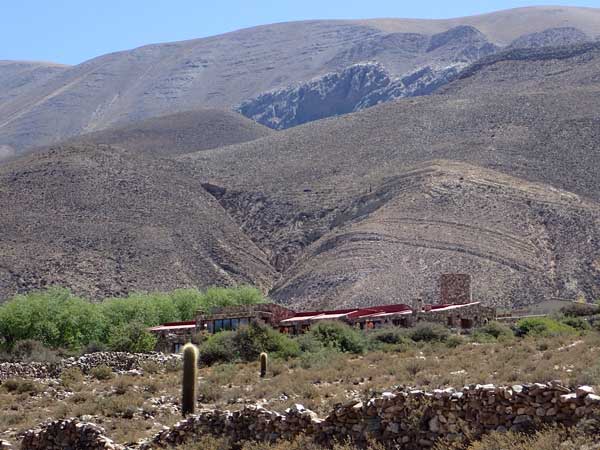 Casa Colorada Hotel 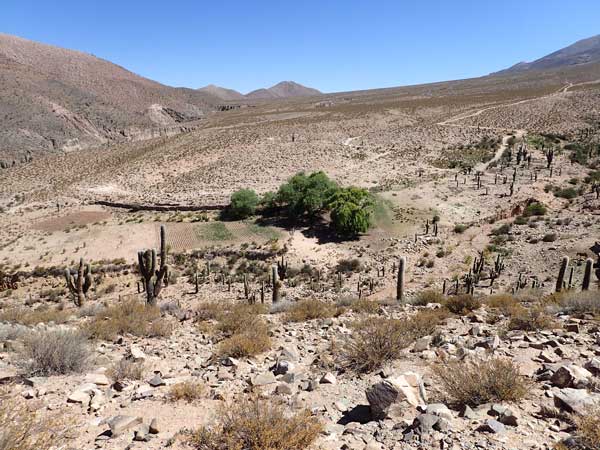 A small holding nearby Soon we were hiking up a steep mule path that has been used for centuries. It was the trading route between the arid highlands and the lowland jungle, the main commodity was salt, exchanged for tropical fruit. We stopped for lunch in the shade of a derelict adobe house. The view of the valley was stunning.  Quebrada de Humahuaca 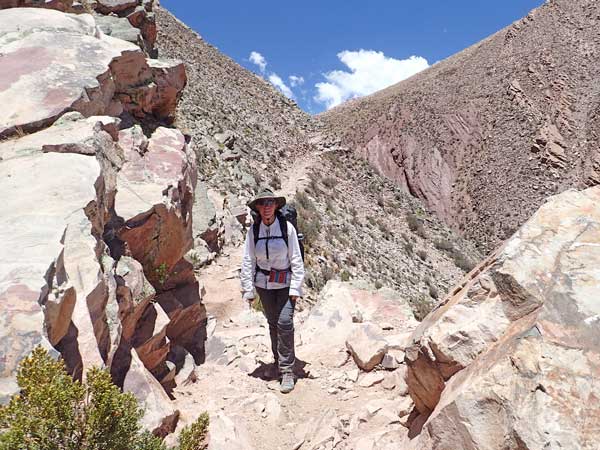 Kath on the mule path After lunch we started meeting locals on the trail, all heading the way we had come; three fit young men with a large friendly dog, a mule caravan and their handlers, a man from Molulo and his wife, dressed for a wander in a park, not a high altitude mountain pass. He told us he was concerned for the welfare of trekkers and felt a system should be put in place using the VHF radios in every settlement to monitor the whereabouts of trekkers and ensure they reached the other side safely. We were grateful such a system didn’t exist! The remains of a dead cow lay half in the river at the valley bottom, then later the stench of death nauseated us, a mule had died on the path and had barely started decomposing. Luckily we had brought our UV water sterilising pen. We were nearing the pass, a vast plateau rather than a ridge, and as we traipsed along, I mused on the effects of altitude; it wasn’t that I felt more tired or out of breath, simply that my pack felt increasingly heavy. 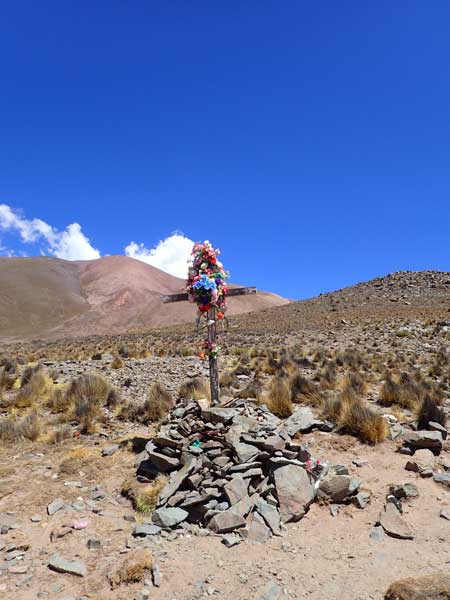 The pass at 4,179m The whole community seemed to be on the march. A group of middle-aged men carrying an empty pole stretcher passed us, one was wearing a fireman’s uniform. Maybe they were going to a funeral. The path forked but luckily a couple of men were coming towards us, an old man leading a mule with an even older man riding. “Excuse me,” I said, “which way is it to Molulo?” “Up.” He replied. But at the crossroads, the road ‘up’ was sign-posted “Las Animas” which according to our rudimentary map was completely the wrong direction for Molulo. It reminded me of my friend Llinos’s story; as a child she used to play on the road between Fairbourne and Pwllheli. If a car stopped to ask for directions to Pwllheli, she would patiently explain. However if the tourists asked for ‘Pull-li-lely’ (English pronunciation), she pointed in the opposite direction. So we took no notice and pressed on. The last group we passed included several very elderly folk, the least able were astride mules. They returned our greeting but nobody smiled. As we dropped down the other side of the mountain, the river disappeared underground, it was lucky that our water bottles were still fairly full. Low clouds gathered and the temperature dropped, but it didn’t rain. The slopes were devoid of vegetation, and we soon understood why when we passed large flocks of goats. Ahead, the lower valleys were green and inviting. 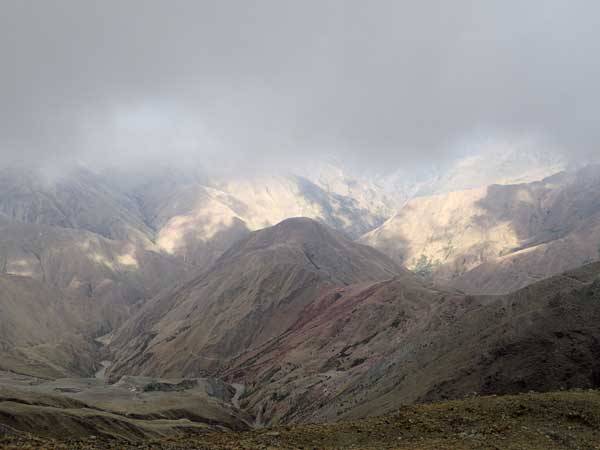 The mountains ahead It was late in the day but our planned ‘campsite’ always seemed to be just around the next corner. We watched a condor swoop low over a valley to the south. A few kilometres further on we arrived at a torrent with a good flow and checked our map, we had overshot, our campsite didn’t look as we had expected. 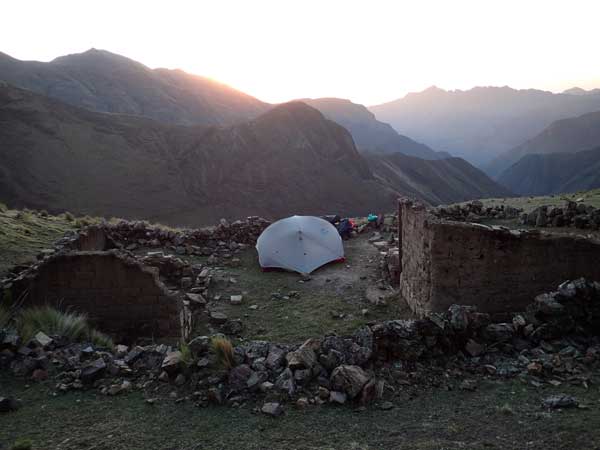 First night camp We erected our tent on the footprint of an old ruin and ate cheesy pasta and cake, washed down with real coffee as we watched the sun set and worked out which way we should head in the morning. It was still dark when the alarm went off at 5:30, so we stayed in bed until six. After breakfast and refilling our water bottles at the stream, we walked past a village at the head of the valley which looked deserted, only the sheep and dogs stirred. As we climbed back up the other side of the river, we passed a friendly man, then a smiley lady. I admired her nimble footedness as she cut straight down the rough slope, ignoring the zig-zags. 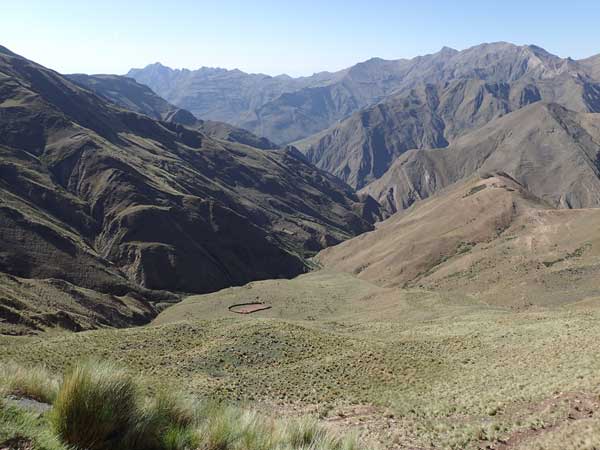 A lot greener already 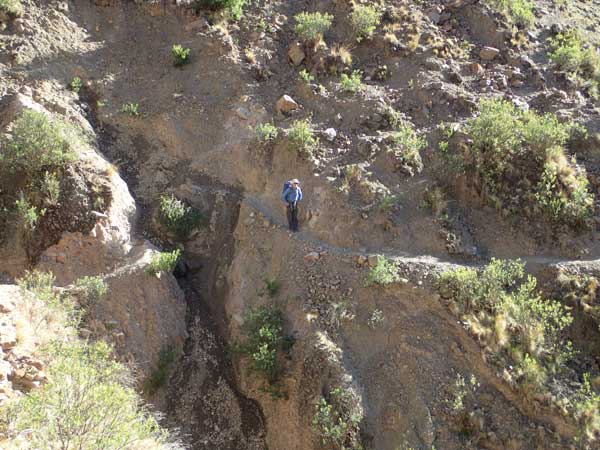 Erosion on the path A little further on, we met another woman who stopped us to ask where we were going but the conversation was a little strange and we wondered if she had learning difficulties. A couple of llamas were grazing in a field and in the sky above a hawk hovered. Later we saw two condors together, a rare sight and concluded one might be a youngster. 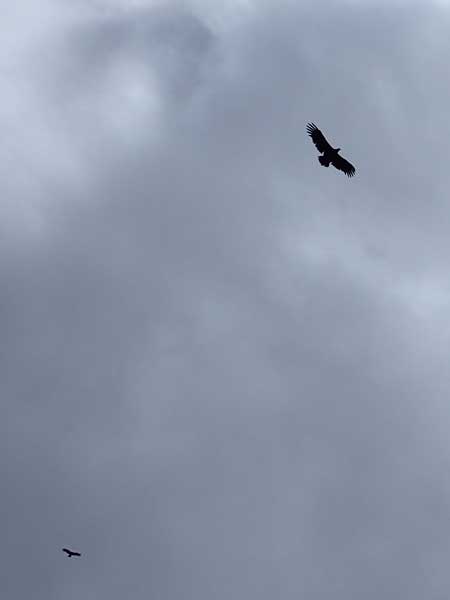 Condors 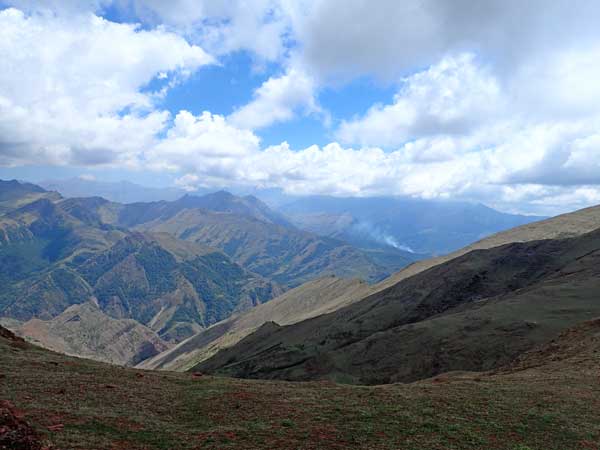 We thought the smoke was from Molulo but it was from a different valley 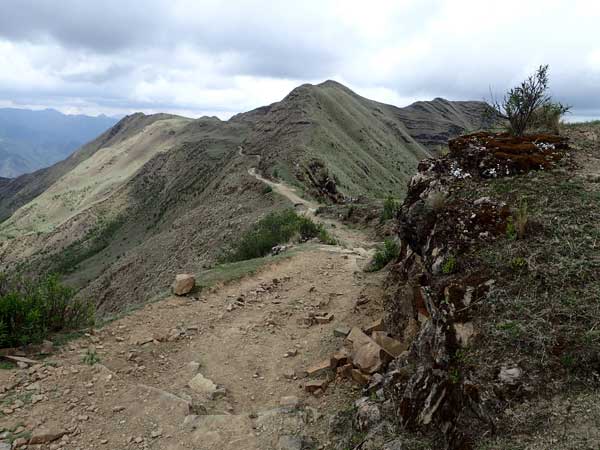 The ridge path into the distance Shortly after lunch we arrived at Molulo cemetery and expected to find the village nearby but when we peered over the ridge, we were surprised to see just a couple of houses and the school, there was no village in sight. The school had been re-roofed since the photos on the internet had been taken. There was nowhere obvious to camp so we headed down to the school as we had heard that it is sometimes possible to stay in one of the dormitories outside of the school term. 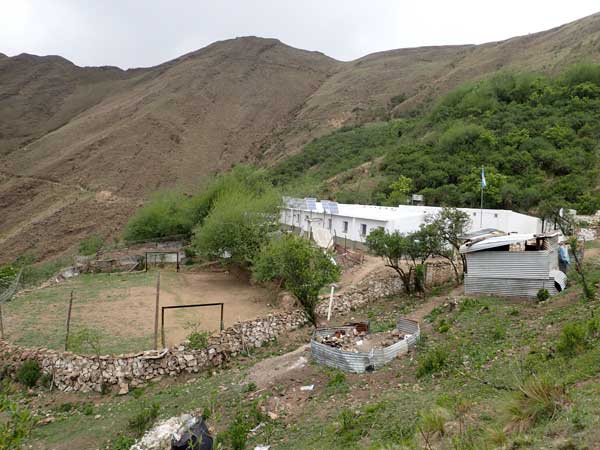 Molulo school At the gate we met a guy wearing a ‘buff’ on his head. He introduced himself as Guillermo and yes of course we could stay, there was nowhere else to go. Did we want some soup? We said no and he introduced us to another teacher, Javier, and told him we didn’t want soup. We felt a little awkward. We had our own food and didn’t want to intrude but it was hard to know what was expected of us. Guillermo explained that there isn’t a Molulo village as such, the name encompasses a vast and remote mountain district. Some of the pupils have to walk two days to get to school. The youngest was four years old and seemed a little lost. The school ‘term’ is unusual, ten days on, ten days off, and all the children board. There is no internet access and all the materials and food have to be brought in on mule-back, something Guillermo organises during is ‘off’ periods. In addition to the four teachers who in many ways are surrogate parents, there is a local man who prepares the meals. Guillermo and Javier are form teachers, Ines teaches gardening, practical skills and art and Roberto is responsible for physical education. We admired their dedication and were surprised to learn that none had volunteered for the post. Education in Jujuy is organised on a provincial base and they could equally have been sent to a wealthy school in the regional capital San Salvador de Jujuy. Guillermo told us he would love to stay forever, whilst poor Roberto was finding the posting very difficult, he has a wife and young son in San Salvador and was finding the separation painful. The study day is split: classes in the morning, then PE and practical skills after lunch with classes resuming from six until eight. After tea the children invited me to play hopscotch (no doubt because they knew I would lose) and Franco thought I was mad on my already creaking knees. I lost. 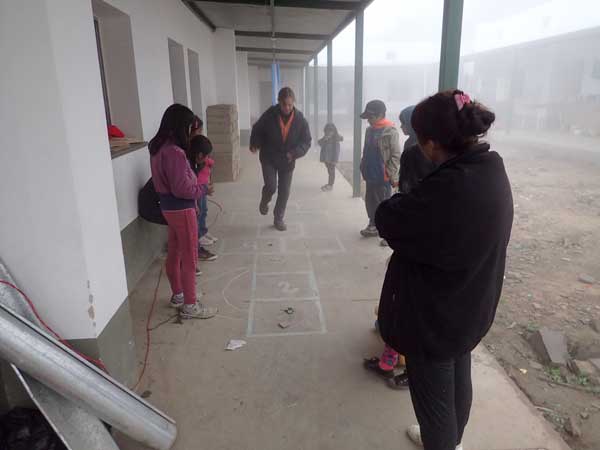 Hopscotch in the fog Ines showed us around the garden which is tended by the children and contributes fresh fruit and vegetables to their diet. The crops were a similar range to what we would grow back home and, as in Chilean Patagonia, slugs are not a problem. We attended the lowering of the flag ceremony and were expected to participate. When our turn came, we had to shout: “Good night children.” To which they replied in unison, “good night tourists!” We giggled. We were beginning to understand the importance of passing trekkers; to alleviate the loneliness of the teachers and provide the children with a glimpse of the world outside their community. Over supper we discussed our sailing journey with Roberto. “I’d love to come with you, will you take me?” He asked, joking. I turned to the kids. “You wouldn’t want him to leave you, would you?” “Oh Yes, we would.” Replied the older boys. “That’s because they all want to come too,” Roberto told us. “These kids can’t wait to get away, into the world.” It rained most of the night but had dried up by the time the sun rose over a beautiful misty landscape. After a hasty breakfast of muesli, we set off at 7am. The girls were all leaning out of their dormitory window waving. We were hopeful the mist would clear. 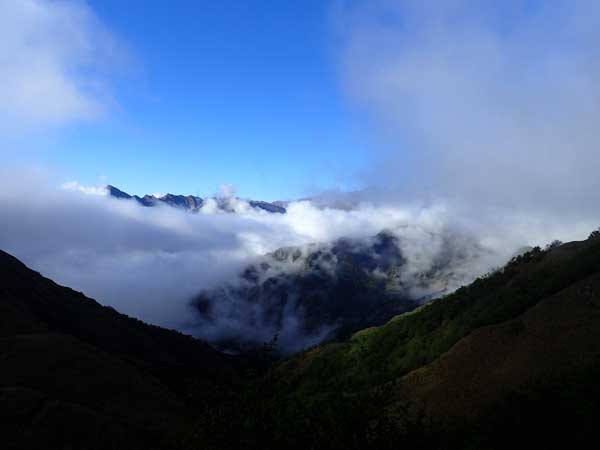 Cloud lifting? But it didn’t and the temperature remained cool as we wove our way along the ridges. Occasional trees gave way to woodland and we marvelled at the rapid transition from the high desert we had set off from in Tilcara. 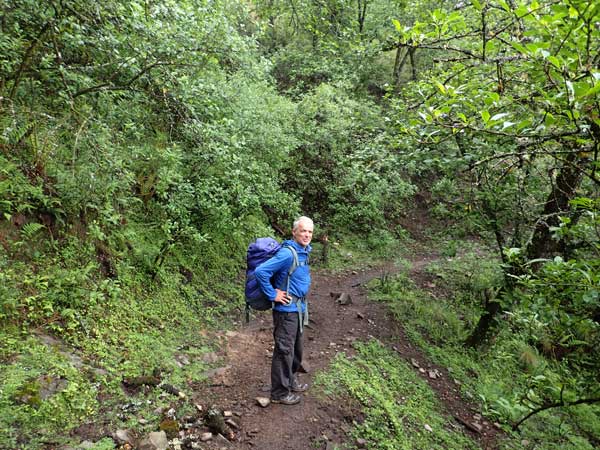 Franco in woodland A couple of fit young men ran past and told us, laughing, that we still had a very long way to go. 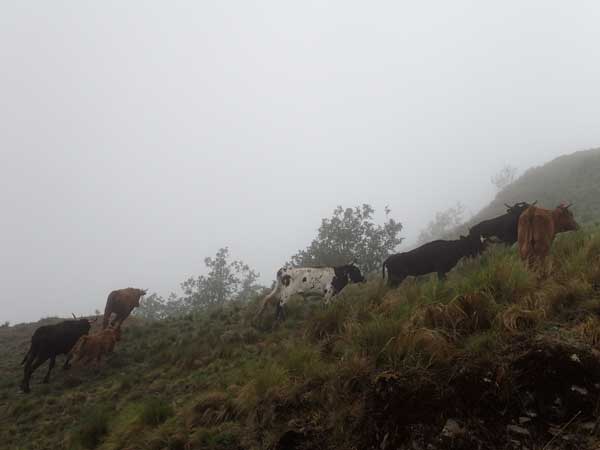 Cows in the mist When the path dropped lower, the vegetation became more jungly but invariably our trail would climb steeply back up to the next ridge. 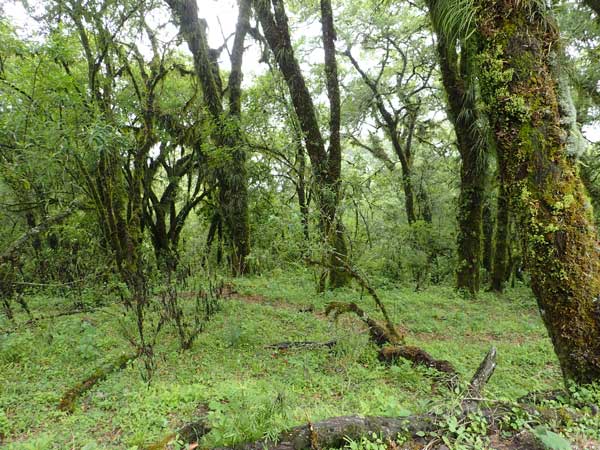 Lush cloud forest Just before the village of San Lucas, we met a young mother with her two boys, maybe they were the kids missing from school. 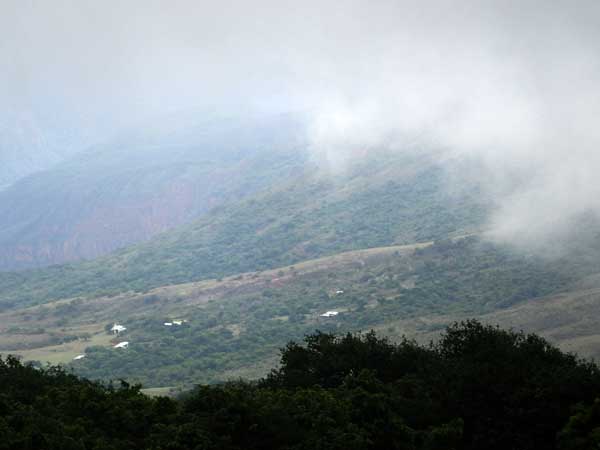 San Lucas in the distance The village was spread out and we didn’t see many people. By the first house, an old lady wearing derelict Adidas trainers asked us if we were looking for the guesthouse. As it was still early we were considering pressing on so we said no. She inquired if we had seen a group of tourists from Buenos Aires with mules as she was expecting guests. We hadn’t. A local lad we had chatted to in Tilcara had also mentioned this group but we hadn’t seen them. Our water supplies had run out so at the very least, we needed to get water. We thought the medical centre might be able to help but all the government buildings appeared shut. We crossed a footbridge and two lively and friendly puppies came bounding over, competing for our attention. “Entertainment at last!” They yelped as they tried to lick our faces. Our waypoints suggested we were near another guest house ‘Doña Teresa’s’ but nothing was signed. Franco knocked on a door and a very elderly couple gave him directions, it was the house the puppies had come from. It had started to drizzle so we decided to stay but nobody was around. In the end we filled our bottles at the garden tap and walked off. One of the puppies, reluctant to lose his newly found source of fun, followed us for a long time, ignoring Franco’s threats. 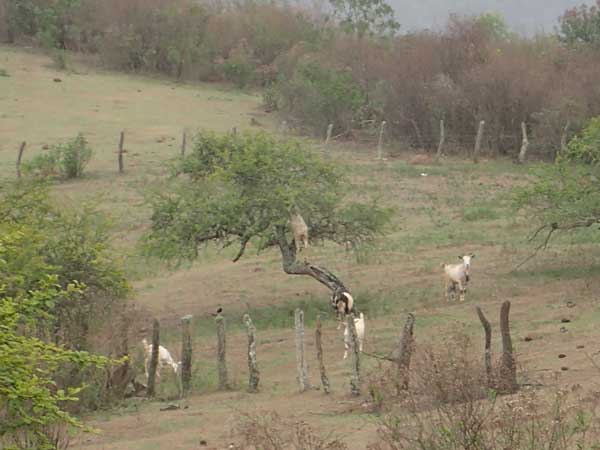 Goat up a tree The rain stopped and we camped just off the path in the woods. My left knee felt like it needed a grease nipple implanted or at least a good seeing to with WD40. 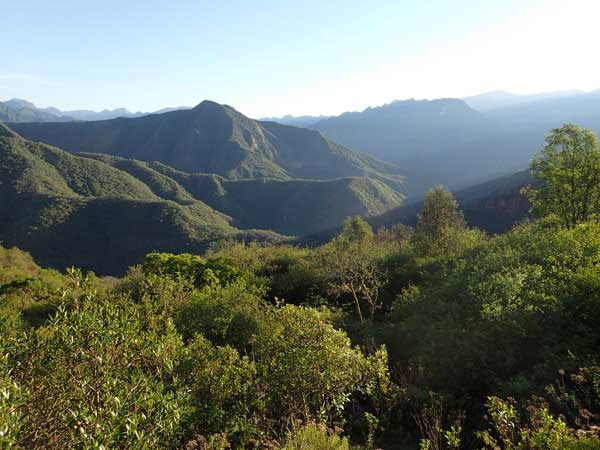 View from the path near our campsite 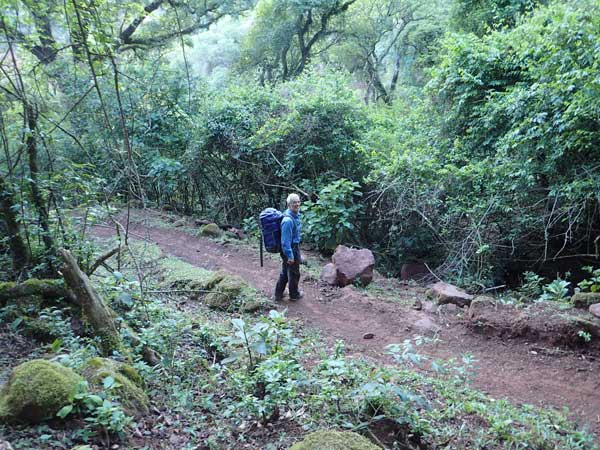 Franco in the jungle The next morning we woke to the chatter of parrots feeding in the tree above our tent. The geology was changing, ahead were bright red sandstone cliffs and the vegetation varied from ‘jungly’ to ‘dry montane woodland’. Below us in the valley bottom, we could hear the rushing river. We passed under three enormous waterfalls but there was no water, not surprising at the end of the dry season. Franco spotted a red headed black woodpecker, and then an ENORMOUS tarantula ... on closer inspection, it proved to be part of the cactus, a clever way to keep birds and insects off? 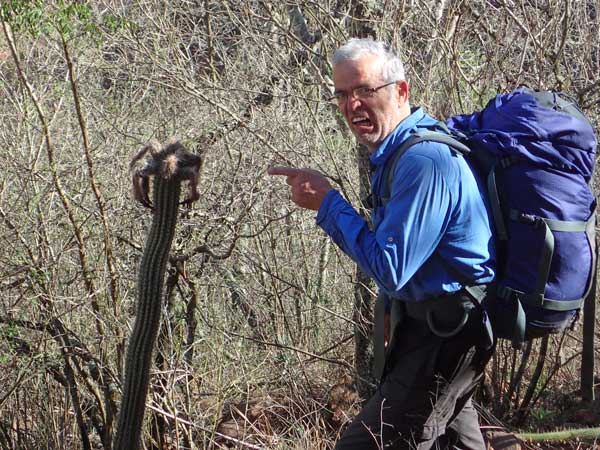 Franco and his ‘tarantula’ 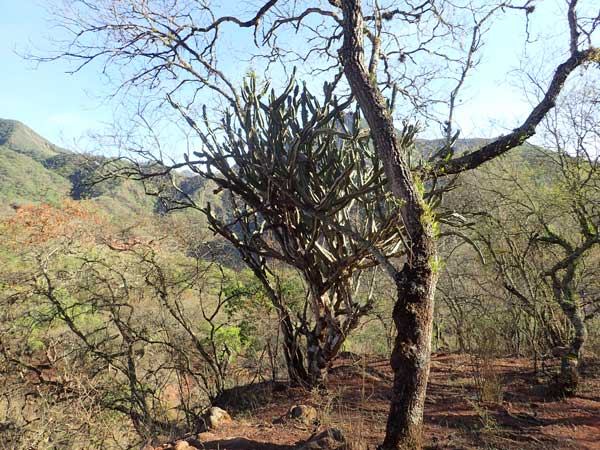 Semi-dry deciduous montane forest 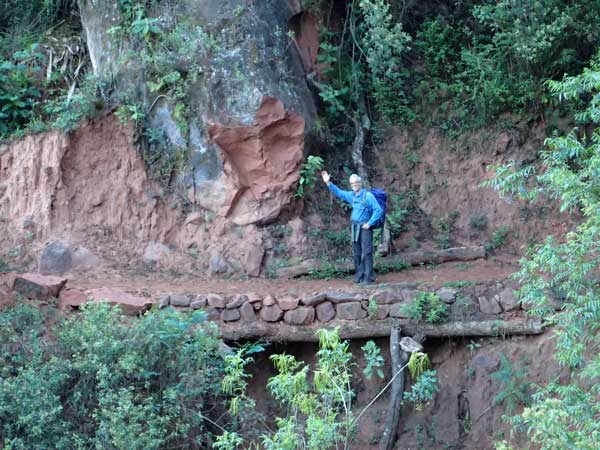 A well maintained trail Our river joined another and changed directions, our path, still high up, followed. Over on the other side of the river, we glimpsed the corrugated roofs of San Francisco reflecting the bright sunshine, it was still a long way off. The path descended steeply to the river where there was a shrine to the Gauchito Antonio Gil and a bridge over to the other side. The Little Gaucho Antonio Gil is an Argentinian folk saint, a kind of Robin Hood who lived in the 1800s and is credited with healing powers. Shrines dedicated to him can be found along roads and paths and people pray to him hoping for a healing miracle. After three days of sweaty walking, we decided a wash would be a good idea before rejoining ‘civilisation’. A narrow path led down the bank to a large natural pool which would have been idyllic had it not been for the sandflies that feasted on us as soon as we emerged from the water. 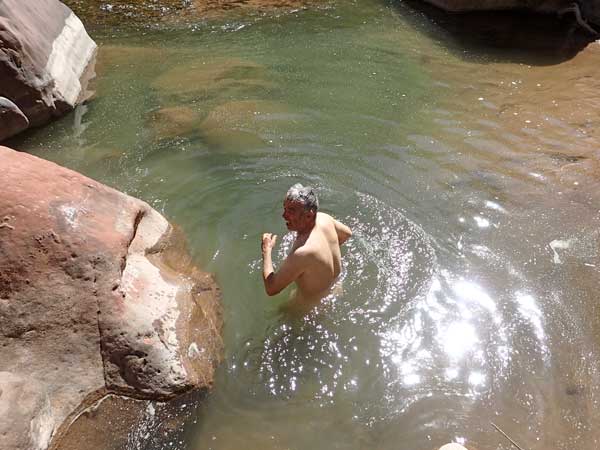 Franco in our private swimming pool Once back on the trail we set a steady pace as we were keen to make San Francisco in time for the daily bus which we had been led to believe left around 5pm. After an hour of walking, we joined a gravel road where two muleteers were loading up their mules. It still took an hour and a half to get to San Francisco, although it wasn’t far in a straight line, the road wound its way in and out of ravines and it wasn’t possible to cut between the loops. 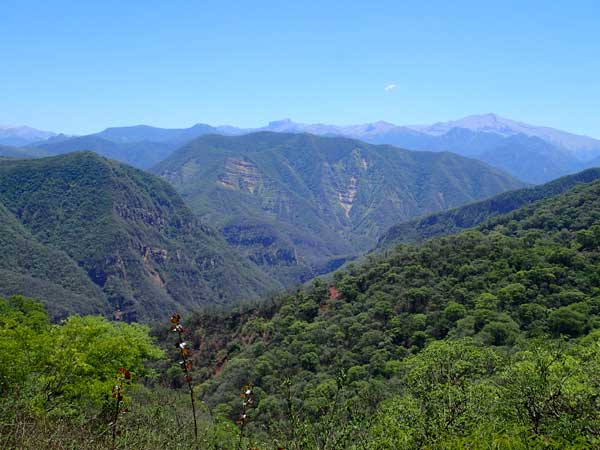 Looking back towards Tilcara 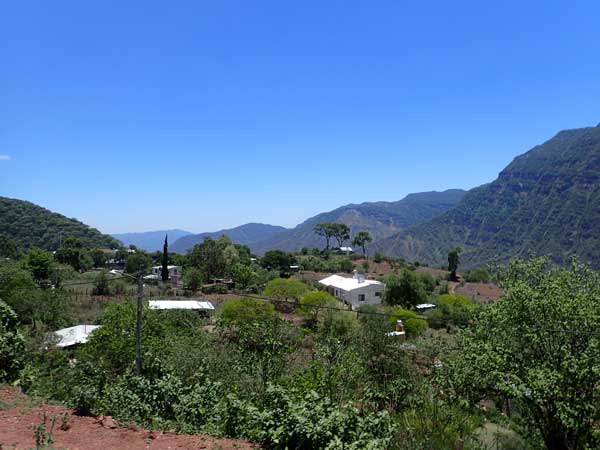 Approaching San Francisco At the first shop we passed, we stopped to buy some fruit. The friendly shopkeeper advised us to reserve our seats on the bus as soon as possible. “The bus is parked near the square, the door is open. Just reserve a seat by leaving a bag or jacket on it.” 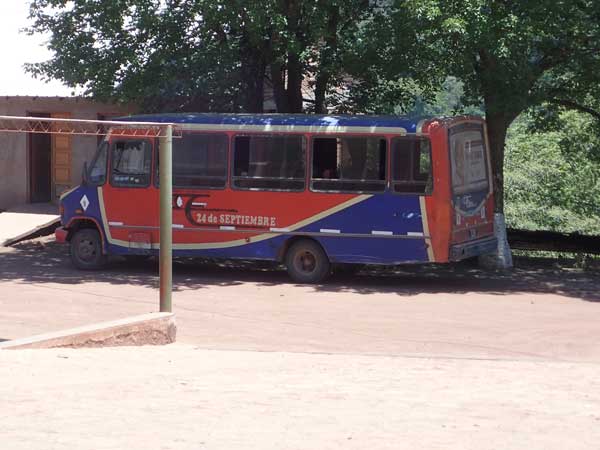 The daily bus The driver was asleep on the front bench and most of the seats had already been bagged. We had a few hours to kill before 5pm so we ate our peaches, the first of the season, in the shade of a church tree. San Francisco is a small and friendly village and plenty seemed to be going on. ‘Queen’s Greatest Hits’ was blasting out the door of the hospital, young men walked past with a cow on a string, the dog from the café broke lose from time to time and took it upon itself to herd the cows, a couple of drunks ordered more beer and kids bought ice lollies. Much to our amazement there was a cash point and were able to take money out, a relief as the taxi fare had cleared out our wallets. The bus took nearly three hours to get down onto the plain, to a town called Libertador General San Martin (General Saint Martin the Liberator - a bit of a mouthful) or Ledesma, its old name. It was founded in 1899 on land donated by the owners of the Ledesma sugar empire. The town was renamed in 1950 but Ledesma remains the largest employer. In the 70s, Ledesma donated land to the Argentinian Government to create a national park, the act wasn’t altogether altruistic as the status would protect the water catchment in perpetuity, and clean water is essential for sugar cane plantations. Ten minutes later we caught a bus to San Salvador de Jujuy, the regional capital. It was half past ten at night by the time we joined the six lane motorway into the city. Franco and I experienced culture shock, for four days we had practically seen no one and had woken up that morning with parrots overhead. Finding a hostel proved to be a disaster (the only time ever in South America), the city centre was full of luxury business hotels so we tried booking a hostel a little way out, through booking.com. We never found it despite the committed efforts of a friendly taxi driver, and the one he eventually dropped us off at was full. I had a romantic image of San Salvador, I had expected a sleepy little town, a smaller version of Salta, not the modern bustling business and legal centre for the north. It wasn’t surprising that teacher Roberto was finding his rural posting difficult. We ended up in an overpriced soulless multi-storey hotel by the canalised river. 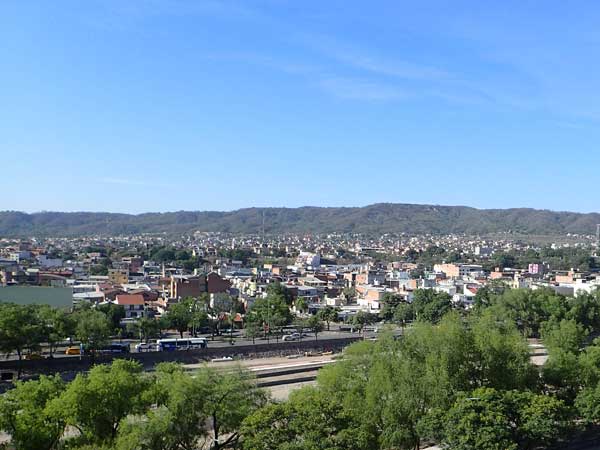 San Salvador from our hotel After breakfast they next morning we walked through the clean and tidy streets back to the taxi ramp. Our driver shared his thoughts on the Macri government. In just one year, he had noticed a big difference. The city was cleaner, corruption was on its way out and inflation had stabilised at a rate of 21%, an incredible improvement on the 41% it had been under the previous ‘Peronist’ government. We caught a bus back to Tilcara to pick up the rest of our luggage and started looking forward to a well deserved lemon meringue pie. 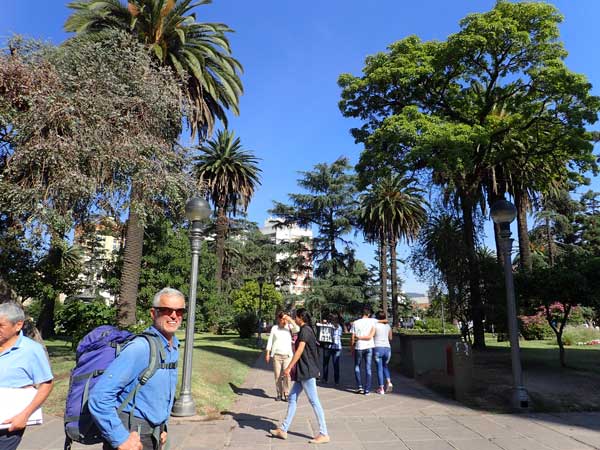 Franco in pleasant city square |